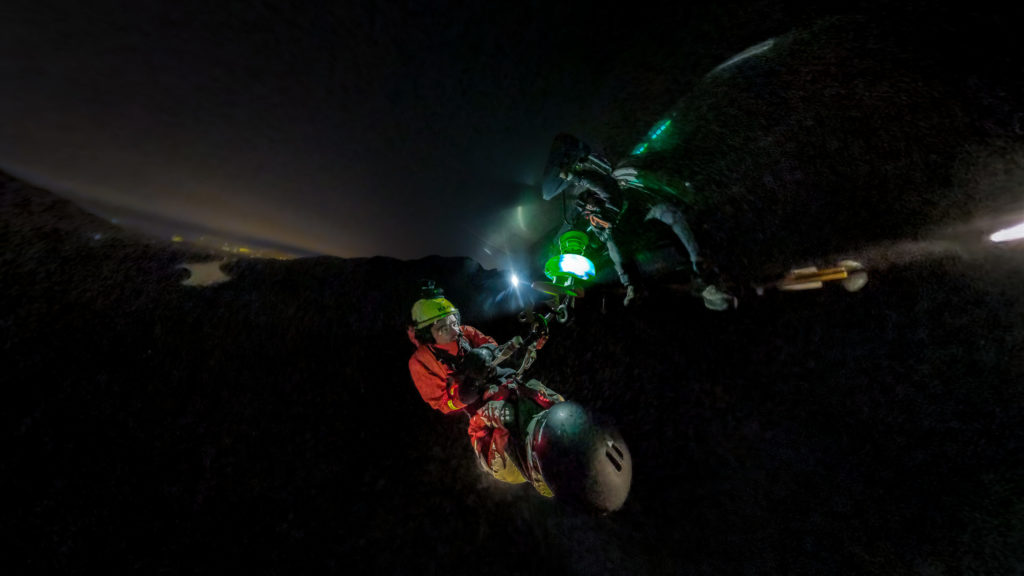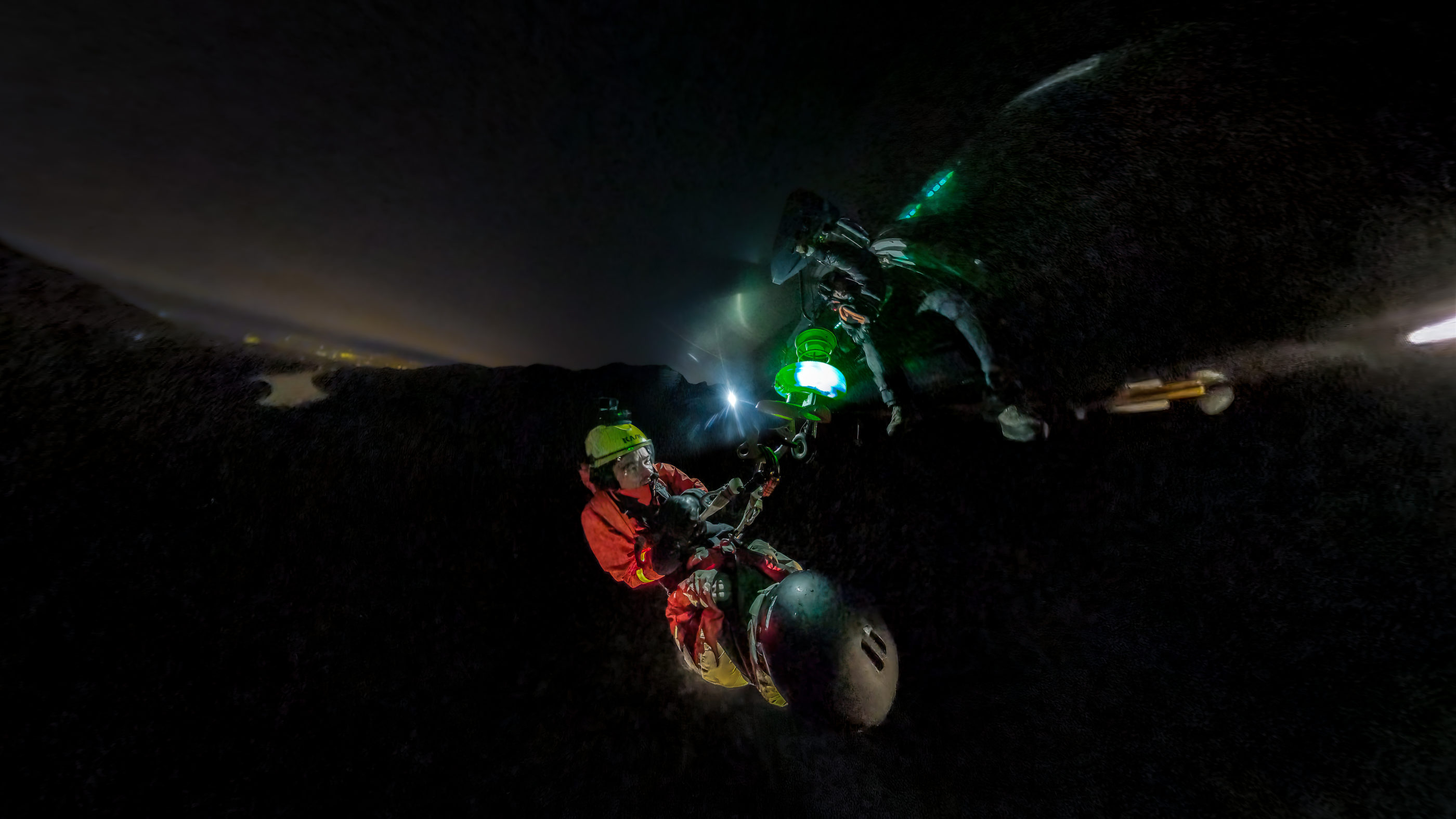By the time people are reported missing in Vancouver’s North Shore Mountains, it’s usually late in the day and darkness is falling. Often, the alarm is raised by family members when skiers, snowboarders and hikers fail to return home. Sometimes, it’s the person themselves who manages to pick up a cell signal and call for help.
That’s what happened on Dec. 22, 2022, when a late afternoon call came in from a snowboarder who had fallen while out-of-bounds at Cypress Mountain, sustaining severe back injuries.
The situation offered the first opportunity for Richmond, B.C.-based Talon Helicopters and North Shore Rescue (NSR), a local search-and-rescue (SAR) organization, to carry out Canada’s first volunteer-led nighttime civilian helicopter hoist rescue.

The capability has been a long time coming, according to Talon Helicopters president Peter Murray. He’s worked with North Shore Rescue since 1991; essentially, Talon provides the aircraft, people and resources to help NSR’s volunteer rescuers get the job done.
For the past five years, Talon has been working to acquire the necessary equipment, training and regulatory approvals to perform a full range of night missions with the help of night vision goggles (NVGs).
In 2017, the company acquired a state-of-the-art Airbus AS365 N2 Dauphin helicopter and equipped it with a traffic collision alert device (TCAD), automatic dependent surveillance-broadcast (ADS-B), helicopter terrain awareness and warning system (HTAWS), three-axis autopilot, and Garmin GTN-750 touchscreen navigator.
“We worked with Transport Canada to get our Dauphin’s night vision imaging system [NVIS] approved and flown by their test pilots,” Murray told Vertical. “It wasn’t in the regulations for civilian operators, so it was all new. We were gaining this capability for firefighting, medevacs, night hoisting — every kind of mission we do. That was one hurdle, which we achieved in August 2019.”

Talon also had to get U.S. State Department approval to use night vision equipment — still a controlled military technology — in civilian work. However, Murray explained that the biggest challenge has come from NSR’s oversight body, Emergency Management B.C. (EMBC).
“When we started the NVG program, EMBC would not allow volunteer SAR members to be on the helicopter at night for any reason, despite us having obtained Transport Canada approval. We suggested a pilot project, which they approved with some limitations — including no night hoisting.”
Murray said that when pressed, EMBC did not explain this decision, other than a vague reference to hoisting being too risky.
The situation came to a head in early October 2022, when Murray said he became “fed up with people with no expertise just saying no.”
He and NSR team lead Mike Danks approached the media with the situation. They described two calls where people had been found at night with the help of NVGs, but Talon and NSR had not been allowed to hoist them out. Instead, the stranded people had to wait for ground crews to arrive.
Shortly afterwards, on Oct. 6, 2022, EMBC reversed its position, noting that it would work to align its approvals more closely with those of Transport Canada.
Finally, they were cleared to perform night hoists using NVG technology.
“Everything we do during the day, we can now do at night,” said Murray.

Reduced risk
Many mountain rescues take place in avalanche territory, where it can be extremely dangerous for ground crews, especially at night.
“Now, volunteers don’t have to put themselves in a riskier position, and fewer volunteers [are required to] get the job done,” explained Murray. “We can lower one or two hoist techs down to the subject and pull them out — versus a ground crew of 10 to 12 people. It’s a huge benefit to reduce risk for our volunteers.”
Plus, he pointed out that many NSR volunteers have day jobs, and a mission that used to take all night can now be wrapped up in a couple of hours. With more and more people venturing into the mountains, many of them unprepared, Murray sees increased demand for rescue services.
“That means either more volunteers for NSR, or you make rescues more efficient,” he said. “Well, this makes us more efficient.”
The capability hasn’t come without great cost. Murray estimated that Talon has spent well over $5 million to obtain night vision approvals, including the cost of the AS365 N2 helicopter, specialized equipment and staff training.

At NSR, volunteers generate donations to pay for hoist operator training, which must be renewed regularly. Some provincial government funding is also available.
While the night hoisting capability will be a welcome addition to B.C.’s SAR toolbox, Murray doesn’t see many other civilian operators following suit.
“We’re in a unique geographic location where NSR is the busiest volunteer SAR team in Canada and they do this on a regular basis,” he said. “I think NVG operations will be standard flying in 20 years; but at the moment, the entry costs are so high that it doesn’t make sense for a lot of operators.”
After 32 years of involvement with NSR, Murray knows what a difference NVGs can make to a rescue operation.
“I’ve been on so many searches where someone is reported missing at 4 p.m., and we have to fly home when it gets dark. Now, we are filling this void where we can help someone out at night.”









